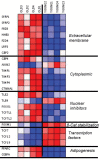WNT signaling suppression in the senescent human thymus
- PMID: 24657825
- PMCID: PMC4351388
- DOI: 10.1093/gerona/glu030
WNT signaling suppression in the senescent human thymus
Abstract
Human thymus is completely developed in late fetal stages and its function peaks in newborns. After the first year of life, the thymus undergoes a progressive atrophy that dramatically decreases de novo T-lymphocyte maturation. Hormonal signaling and changes in the microRNA expression network are identified as underlying causes of human thymus involution. However, specific pathways involved in the age-related loss of thymic function remain unknown. In this study, we analyzed differential gene-expression profile and microRNA expression in elderly (70 years old) and young (less than 10 months old and 11 years old) human thymic samples. Our data have shown that WNT pathway deregulation through the overexpression of different inhibitors by the nonadipocytic component of the human thymus stimulates the age-related involution. These results are of particular interest because interference of WNT signaling has been demonstrated in both animal models and in vitro studies, with the three major hallmarks of thymic involution: (i) epithelial structure disruption, (ii) adipogenic process, and (iii) thymocyte development arrest. Thus, our results suggest that secreted inhibitors of the WNT pathway could be explored as a novel therapeutical target in the reversal of the age-related thymic involution.
Keywords: Aging.; Human thymus; Thymus involution; WNT pathway.
© The Author 2014. Published by Oxford University Press on behalf of The Gerontological Society of America. All rights reserved. For permissions, please e-mail: journals.permissions@oup.com.
Figures




Similar articles
-
The role of zinc in pre- and postnatal mammalian thymic immunohistogenesis.In Vivo. 1998 Nov-Dec;12(6):695-722. In Vivo. 1998. PMID: 9891234
-
Involution of the mammalian thymus, one of the leading regulators of aging.In Vivo. 1997 Sep-Oct;11(5):421-40. In Vivo. 1997. PMID: 9427047
-
Wnt4 signaling is associated with the decrease of proliferation and increase of apoptosis during age-related thymic involution.Mol Med Rep. 2015 Nov;12(5):7568-76. doi: 10.3892/mmr.2015.4343. Epub 2015 Sep 21. Mol Med Rep. 2015. PMID: 26397044
-
Thymus aging and immune reconstitution, progresses and challenges.Semin Immunol. 2023 Nov;70:101837. doi: 10.1016/j.smim.2023.101837. Epub 2023 Aug 31. Semin Immunol. 2023. PMID: 37659170 Review.
-
Epigenetic modifications in thymic epithelial cells: an evolutionary perspective for thymus atrophy.Clin Epigenetics. 2021 Nov 24;13(1):210. doi: 10.1186/s13148-021-01197-0. Clin Epigenetics. 2021. PMID: 34819170 Free PMC article. Review.
Cited by
-
Temporal expression patterns of the melatoninergic system in the human thymus of children.Mol Metab. 2019 Oct;28:83-90. doi: 10.1016/j.molmet.2019.07.007. Epub 2019 Jul 24. Mol Metab. 2019. PMID: 31378599 Free PMC article.
-
Thymic microenvironment's impact on immunosenescence.Immunol Res. 2024 Oct;72(5):1161-1173. doi: 10.1007/s12026-024-09519-z. Epub 2024 Jul 23. Immunol Res. 2024. PMID: 39042204
-
Thymic stromal cells: Roles in atrophy and age-associated dysfunction of the thymus.Exp Gerontol. 2018 May;105:113-117. doi: 10.1016/j.exger.2017.12.022. Epub 2017 Dec 24. Exp Gerontol. 2018. PMID: 29278750 Free PMC article. Review.
-
Conserved genes and pathways in primary human fibroblast strains undergoing replicative and radiation induced senescence.Biol Res. 2016 Jul 28;49(1):34. doi: 10.1186/s40659-016-0095-2. Biol Res. 2016. PMID: 27464526 Free PMC article.
-
Signaling Crosstalks Drive Generation and Regeneration of the Thymus.Front Immunol. 2022 Jun 6;13:920306. doi: 10.3389/fimmu.2022.920306. eCollection 2022. Front Immunol. 2022. PMID: 35734178 Free PMC article. Review.
References
-
- Haynes BF, Markert ML, Sempowski GD, Patel DD, Hale LP. The role of the thymus in immune reconstitution in aging, bone marrow transplantation, and HIV-1 infection. Annu Rev Immunol. 2000;18:529–560. :10.1146/annurev.immunol.18.1.529 - PubMed
-
- Chiodi H. The relationship between the thymus and the sexual organs. Endocrinology. 1940;26:107–116. http://dx.doi.org/10.1210/endo- 26-1-107
-
- Steinmann GG. Changes in the human thymus during aging. Curr Top Pathol. 1986;75:43–88. - PubMed
-
- Henry L. Involution of the human thymus. J Pathol Bacteriol. 1967;93:661–671. :10.1002/path.1700930227 - PubMed
-
- Welniak LA, Sun R, Murphy WJ. The role of growth hormone in T-cell development and reconstitution. J Leukoc Biol. 2002;71:381–387. :10.1189/jlb.1938-3673 - PubMed
Publication types
MeSH terms
Substances
Grants and funding
LinkOut - more resources
Full Text Sources
Other Literature Sources
Medical

